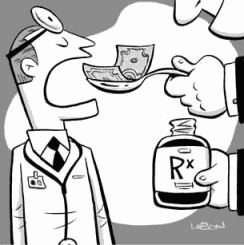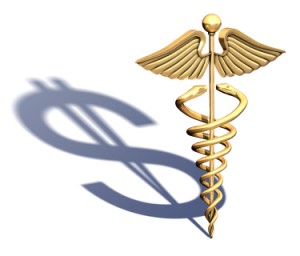__
Everyone’s talking about vitamin D right now, especially since the Institute of Medicine’s Food and Nutrition Board (FNB) updated their recommended dietary allowance (RDA) for it.

Há interesses na gestão da Medicina associados com os da Indústria Farmacêutica e não com a preservação da saúde
By Dr. Joseph Mercola
Mercola.com
What if a cure for cancer has been right here all along? What if the very agency charged with protecting your health is the one keeping you from that cure?
A Lawless, Rogue Agency Out of Control
Ten years ago a former New York State assemblyman, Daniel Haley, wrote a scathing exposé on how the Federal Drug Administration (FDA) systematically shuts the door on effective and non-toxic products, many for cancer.
The FDA is the chief agency in charge of protecting and promoting Americans’ health and safety. But in 10 stunning, true stories in his book, “The Politics of Healing,” Haley describes how the FDA has suppressed and banned natural health cures – eight of them for cancer.
He later wrote about two additional cancer cures that worked, which the FDA also disallowed.
The FDA even admitted that one of these treatments, discovered by Dr. Stanislaw Burzynski, was successful with some of the most incurable forms of cancer.
I shared this with you in a recent article that showed his film, but stories like this are far too common, and you can’t help but wonder how many people have died while the FDA denied them cancer treatments that work.
Haley brazenly calls the FDA a rogue, out of control agency that has lied in Congressional testimonies, deliberately falsified data, and destroyed evidence to prohibit cures like Burzynki’s from coming to market. The FDA’s loyalties are to the drug industry, not to individuals, Haley says.
His claims mirror those of Dr. David Graham, who once worked in the FDA’s Office of Drug Safety. In 2004 Dr. Graham blew the whistle on six drugs that were harming people, including Vioxx, but instead of acting on his warnings, Graham’s superiors pulled him off his job.
He fought back in a PBS television special when he told how he’d been chastised at the FDA for thinking the FDA served the public. The “FDA is there to serve the drug industry,” Graham said his supervisors told him.
‘Virtually Every’ Drug Company Now Targeting Cancer Therapies
Today, the FDA continues to serve its client, Big Pharma, by making sure that toxic chemotherapy, along with surgery and radiation, are the only cancer treatment options legally available to you. This industry is huge, with 139 cancer treatment drugs in the pipeline just for women alone.
All told there are over 900 experimental cancer therapies under investigation. No wonder so many pharmaceutical companies are ramping up their cancer drug research!
According to the New York Times:
“Virtually every large pharmaceutical company seems to have discovered cancer, and a substantial portion of the smaller biotechnology companies are focused on it as well. Together, the companies are pouring billions of dollars into developing cancer drugs.”
Note they said drugs, not cures. That’s because this industry isn’t set up for a cure, even though they say that’s what they’re looking for. It’s also why economic forecasts predict 20 million new cancers by 2025, with the $50 billion-a-year cancer treatment business increasing by 15 percent a year. Pfizer alone projects its annual cancer drug returns will be $11 billion by 2018.
The truth is that most Americans are deficient in vitamin D, and studies show that vitamin D supplementation can both prevent and kill many infections and diseases, including cancer.
Vitamin D isn’t actually a vitamin, although scientists refer to it as such. It’s actually a steroid hormone that you get from sun exposure, food sources and/or supplementation.
The term refers to either vitamin D2 or D3, but according to the National Vitamin D Council, D3 (chemical name 25-hydroxy vitamin D) is real vitamin D, and is the same substance produced naturally through your skin by sun exposure.
Older research appears at odds on whether your body cares which form of D it’s getting. But a study in the January 2011 Journal of Clinical Endocrinology & Metabolism found that D3 is 87 percent more effective than D2, and is the preferred form for treating vitamin D deficiency. It’s measured in international units (IU’s) in nanograms per milliliter, or ng/mL.
The Vitamin D Council believes that a person’s D3 levels should be at least 50 ng/mLfor your body to function properly. (To determine whether you might be deficient, you need to get your vitamin D levels tested, and ideally, you’ll want to get tested regularly thereafter to ensure you’re maintaining optimal levels year-round.)
Fourteen famous vitamin D researchers gave the FNB this information, but the FNB apparently ignored the information that the researchers presented because their “updated” RDA levels ended up being so pitifully low that it’s doubtful it can significantly impact Americans’ deficiency, let alone fight off diseases like cancer and heart disease.
Experts Protest ‘Impossible’ New RDA Levels
Depending on your age, the new recommendations are 600 to 800 IUs a day for adults and between zero and 600 IUs a day for children. The FNB also said that taking vitamin D in amounts of 10,000 IUs or more could be dangerous – but that’s ridiculous, seeing that a 30-minute dose of sunshine can give an adult more than 10,000 IUs!
Since countless studies indicate that much higher levels of vitamin D are required for optimal health, it’s no surprise that experts lost no time denouncing the FNB’s recommendations.
“It’s almost impossible to significantly raise your vitamin D levels when supplementing (at the FNB levels),” the Vitamin D Council posted on its website.
Hidden Agendas and Conflicts of Interest
Suspecting that conflicts of interest and hidden agendas played a part in this, the Vitamin D Council filed Freedom of Information (FOIA) requests so they could examine the FNB’s notes on the process.
They’re still waiting on an answer, but I’m wondering if it doesn’t have something to do with the fact that over 1,350 clinical trials on vitamin D are currently being conducted by major drug companies, all based on the prevention or cure of many illnesses and diseases, including 388 for cancer.
Yes, cancer.
From breast to prostate, to colorectal to brain cancers, and even basal cell carcinoma (skin cancer), Drug companies such as Pfizer and Merck are currently either sponsoring or collaborating on clinical trials based on the premise that vitamin D administered orally, intravenously or topically (for skin cancer) may either prevent or cure cancer.
Cancer foundations and institutes are all in on the clinical study game as well, such as the National Cancer Institute and the National Institutes of Health. Even the U.S. Department of Defense and the Department of Veteran Affairs are studying ways to prevent and cure cancer with vitamin D!
What’s really interesting is that several of these studies are using vitamin D in amounts of 50,000 IUs a day or more – which flies strongly in the face of the FNB’s claims that self-supplementing with 10,000 could be dangerous to your health.
Since recent studies show that supplements of up to 40,000 IUs a day don’t appear to be toxic, and that doses as low as 400 IUs a day are too low to even maintain skeletal health, let alone prevent cancer.
The FDA’s Definition of Drug vs. Supplement
Over 800 studies already show that vitamin D could have cancer-prevention and/or treatment possibilities. But the problem is that it’s a natural substance that can’t be patented as a simple supplement, meaning there’s no real revenue in it, compared to a prescription brand drug.
That’s why many drug studies involving vitamins of any kind hinge on how the FDA defines drugs and supplements.
A drug is defined as a product meant for the diagnosis, cure, mitigation, treatment, or prevention of a disease.
A supplement is defined as a product that is meant to simply “supplement” or “enhance” a normal diet within the daily allowances recommended by the FDA. Drugs – and retailers who sell supplements are not allowed to tell you that vitamin D can possibly “prevent, mitigate or cure” cancer without having the FDA accuse them of selling a drug that hasn’t been approved through the proper FDA process.
Again, Follow the Money if You Want to Know the Truth
That process of getting a drug to market costs an average $359 million and takes nearly 10 years– with a good portion of the money going directly to the FDA through user fees. Over the years these fees have become a major funding source for the FDA. What drug companies get in return is faster FDA reviews and drug approvals.

Doenças que já têm cura ou prevenção são mantidas por interesses contrários aos da saúde
As a result, a kind of you-scratch-my-back-I’ll-scratch-yours scenario has ensued, with drug companies maintaining major leverage over the FDA when it comes to protecting their revenue sources, including making sure the $60 billion-a-year supplement business doesn’t get in the way of drug sales.
The history of FDA laws and regulations on file at Harvard Law School, explains how years ago an FDA task force long ago established this policy
“… to ensure that the presence of dietary supplements on the market does not act as a disincentive to drug development.”
So how does this relate to too-low RDA levels for vitamin D?
A look at the clinical trials shows that most of them involve “high-potency” D3 supplements, which puts them in the drug category if it turns out they can mitigate, treat or cure cancer. And that means they can be patented – and sold to you as prescriptions at sky-high prices.
Drug Companies Are Elbowing Their Way into Your Healthcare Plan
Another way that Big Pharma has moved in on the cancer industry is through pharmacy benefit managers (PBMs), which administer drug benefits for about 95 percent of all patients with prescription drug coverage.
PBMs decide which drugs flow through the healthcare system. Supposedly they choose the best drugs and prices for your plan. But what if I told you that the businesses that sell the drugs have been helping to decide which drugs your PBM pays for?
Regulators have been working hard to nip conflicts of interest in the bud, but over the years numerous court cases have shown that drug companies and PBMs working together has led to higher prices and limited drug choices – and allegations of price-setting through secret deals with pharmaceutical companies.
Official Agencies Wedded to Toxic Chemotherapy
I have an employee who was diagnosed with breast cancer last year. After her mastectomy, she was told she had several months of chemotherapy and radiation ahead of her. But she sought a second opinion at a renowned cancer treatment center – and learned that chemotherapy was NOT going to be part of her treatment plan because her type of cancer doesn’t respond to chemotherapy.
“And since chemo is poison, why would we want to poison you for no reason?” the oncologist told her.
That’s right – a person in the business of “selling” cancer treatment actually said he wasn’t going to poison her “for no reason” – something I consider unusual in an industry that is wedded to toxic chemotherapy.
The employee was pronounced cancer-free four months later, without chemo or radiation, which may leave you wondering, as it did me, how many patients die every year from toxic chemotherapy they got but didn’t need?
Some experts believe that as much as 25 percent, or more, of patients who undergo chemotherapy are killed by it. Dr. Vincent Speckhart, a former U.S. Air Force flight surgeon and oncologist, was so concerned about deaths from chemo that he told a Congressional committee:
“After 13 years of using FDA-approved chemotherapy protocols, I concluded that such therapies were extremely toxic, poorly tolerated, and not effective in prolonging survival in most solid tumors of adults. In 1983, my patients began to request therapies other than chemotherapy. I agreed, and without even knowing it, I became an ‘alternative practitioner’ and was red-flagged by opponents of this form of therapy.”
In other words, if you’re a physician who divorces the status quo of cancer treatment, you’d better watch out.
In his book, Haley talks about how this “gross government intrusion into the healing arts,” costs thousands – and perhaps millions – of lives and facilitates the drug industry by squelching people like Dr. Speckhart and Burzynski.
Arm Yourself with Knowledge to Protect Your Healthcare Freedom
It doesn’t help that the FDA as well as other “official cancer medicine” agencies have a swinging door of employees going back forth between the agency and Big Pharma to work.
In a new book, “National Cancer Institute and American Cancer Society: Criminal Indifference to Cancer Prevention and Conflicts of Interest,” former Cancer Prevention Coalition president Dr. Samuel S. Epstein shows just how bad the conflicts are.
Quoting former NCI director Samuel Broder, Epstein says “the NCI has become a government pharmaceutical company.” And the ACS, Epstein says, is more interested in “accumulating wealth than saving lives.”
With close ties to cancer treatment businesses, the ACS has a track record that “clearly reflects conflicts of interest” when it comes to cancer treatment policies and prevention strategies, Epstein alleges.
And so it goes… So, what you can do to protect yourself from getting cancer, or what can you do if you already have it? The good news is that knowledge is power, and there are things you can do for yourself, right now, not to only to prevent cancer, but to make sure you have the right cancer treatment if you do get it.
Because cancer is almost wholly a man-made disease, it’s especially important to recognize that you do have power over many things that could cause you to get cancer. Taking control of your health will put you in a position to make the best health decisions possible if you do get cancer.
Here’s a list to get you started on a cancer prevention plan:
- Normalize your vitamin D levels with safe amounts of sun exposure. This works primarily by optimizing your vitamin D level. Ideally, monitor your vitamin D levels throughout the year.
- Control your insulin levels by limiting your intake of processed foods and sugars/fructose as much as possible.
- Get appropriate amounts of animal-based omega-3 fats.
- Get appropriate exercise. One of the primary reasons exercise works is that it drives your insulin levels down. Controlling insulin levels is one of the most powerful ways to reduce your cancer risks.
- Eat according to your nutritional type. The potent anti-cancer effects of this principle are very much underappreciated. When we treat cancer patients in our clinic this is one of the most powerful anti-cancer strategies we have.
- Have a tool to permanently erase the neurological short-circuiting that can activate cancer genes. Even the CDC states that 85 percent of disease is caused by emotions. It is likely that this factor may be more important than all the other physical ones listed here, so make sure this is addressed. My particular favorite tool for this purpose, as you may know, is the Emotional Freedom Technique.
- Only 25 percent of people eat enough vegetables, so by all means eat as many vegetables as you are comfortable with. Ideally, they should be fresh and organic.Cruciferous vegetables in particular have been identified as having potent anti-cancer properties. Remember that carb nutritional types may need up to 300 percent more vegetables than protein nutritional types.
- Maintain an ideal body weight.
- Get enough high-quality sleep.
- Reduce your exposure to environmental toxins like pesticides, household chemical cleaners, synthetic air fresheners and air pollution.
- Reduce your use of cell phones and other wireless technologies, and implement as many safety strategies as possible if/when you cannot avoid their use.
- Boil, poach or steam your foods, rather than frying or charbroiling them.
You also can help by voicing your opposition to the FDA’s censorship of alternative cancer treatments by sending a letter to your Congressional representatives and asking them to support H.R. 1364, a bill to amend the Federal Food, Drug, and Cosmetic Act concerning the distribution of information on legitimate scientific research in connection with foods and dietary supplements.
Call or write your Congressman now, and stop the censorship of your right to alternative cancer therapies and possibly a cure.
Sponsored Link: The FDA is moving to BAN most natural health supplements. – Get them while you still can! Wellness Resources – High Quality Nutritional Supplement(Ad)
Fonte: http://theintelhub.com/2011/08/05/the-stunning-effect-of-this-single-vitamin-on-cancer/
__
-30.039254
-51.216930
Compartilhe esta postagem:
 Prof Mitch Blair (pictured) said, ‘We know vitamin D deficiency is a growing problem and research reveals startling high levels of vitamin deficiency among certain groups including children.
Prof Mitch Blair (pictured) said, ‘We know vitamin D deficiency is a growing problem and research reveals startling high levels of vitamin deficiency among certain groups including children.




 Exposição à luz solar pode ajudar pacientes de asma que não respondem bem a esteróides
Exposição à luz solar pode ajudar pacientes de asma que não respondem bem a esteróides











